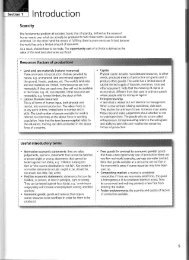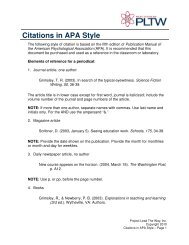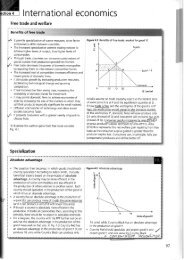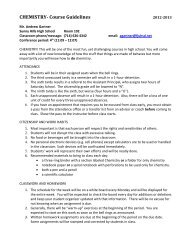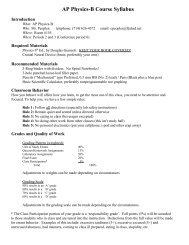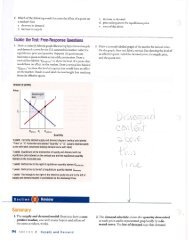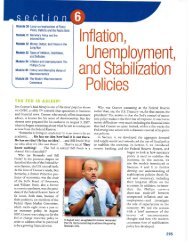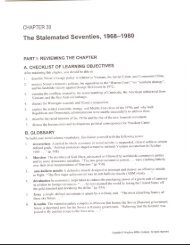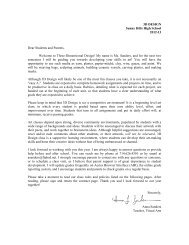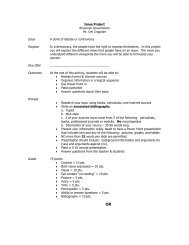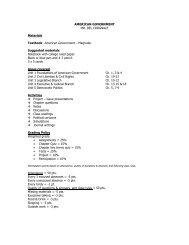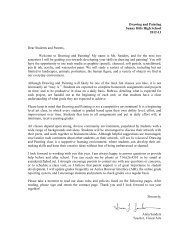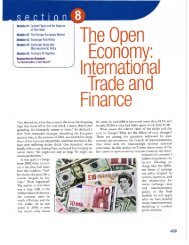IB Econ Chap 26 Terms of Trade - Sunny Hills High School
IB Econ Chap 26 Terms of Trade - Sunny Hills High School
IB Econ Chap 26 Terms of Trade - Sunny Hills High School
You also want an ePaper? Increase the reach of your titles
YUMPU automatically turns print PDFs into web optimized ePapers that Google loves.
!!!!!<br />
.9 Eo<br />
lo<br />
c<br />
.9<br />
E<br />
318<br />
<strong>26</strong> o <strong>Terms</strong> <strong>of</strong> trade<br />
Year I<br />
Year 2<br />
Year 3<br />
Year 4<br />
Year 5<br />
Year 6<br />
r00<br />
r02<br />
106<br />
I0<br />
108<br />
106<br />
Table <strong>26</strong>.1 <strong>Terms</strong> <strong>of</strong> trade igures<br />
i00<br />
100<br />
104<br />
110<br />
r06<br />
r08<br />
ffixroo<br />
ffixroo<br />
r06<br />
104<br />
|0..<br />
I t0 "<br />
t08 ..<br />
l(lt)<br />
x 100<br />
import prices is relatively more great and so the TOT value falls a<br />
little Lo 101.92. We say that there has been a detedoration in the<br />
TOT, which means LhaL a givcn amount <strong>of</strong> cxports can buy fewer<br />
imports than in year 2. However, the TOT in year 3 are still better<br />
than in year l. In year 4, import prices dse by relatively more than<br />
export prices and so the value <strong>of</strong> the TOT falls again, back to 100. So<br />
in year 4 a given amount <strong>of</strong> exports will buy the samc amounL <strong>of</strong><br />
imp<strong>of</strong>is as in year I. In year 5 export pdces fall but import priccs fall<br />
by more, whicb this lcads to an improvement in the TOT and the<br />
value rises to I0I.89.<br />
We can sce from the example that if export pdces rise relative to<br />
import prices, or if they lall by relatively less than imporL prices fall,<br />
lhen the TOT will improve. In the same way, if import prices dse by<br />
more than export prices. or iI rhey fall by relatively less than exporl<br />
prices fall, then the TOT will dctcriorate.<br />
The key thing to realize is that if the TOT improve, then a given<br />
quantity <strong>of</strong> cxports will buy a larger quantity <strong>of</strong> imports than bcfore.<br />
We <strong>of</strong>ten talk about a "basket" <strong>of</strong> exports, in the same way as<br />
mcasuring inflation. I1 the price <strong>of</strong> a basket <strong>of</strong> exports lalls, Lhcn a<br />
country will need to sell more exports in order to kccp imporLs at the<br />
same level.<br />
Student workpoint <strong>26</strong>.1<br />
Be a thinker<br />
I Using the data in Table <strong>26</strong>.1 , calculate the TOT for year 6.<br />
2 Describe the changes !n the TOT from year 5. What does this mean<br />
about the "buying power" <strong>of</strong> the country's exports?<br />
5 How does the buying power <strong>of</strong> the country's exports in year 6<br />
compare with year I ?<br />
Asses$nent odviae: ln HL paper 3, you may be asked to calculate the terms <strong>of</strong><br />
trade as in workpoint <strong>26</strong>.1 .<br />
r00<br />
100<br />
r00<br />
102<br />
t0r.92<br />
100<br />
101.89<br />
']



